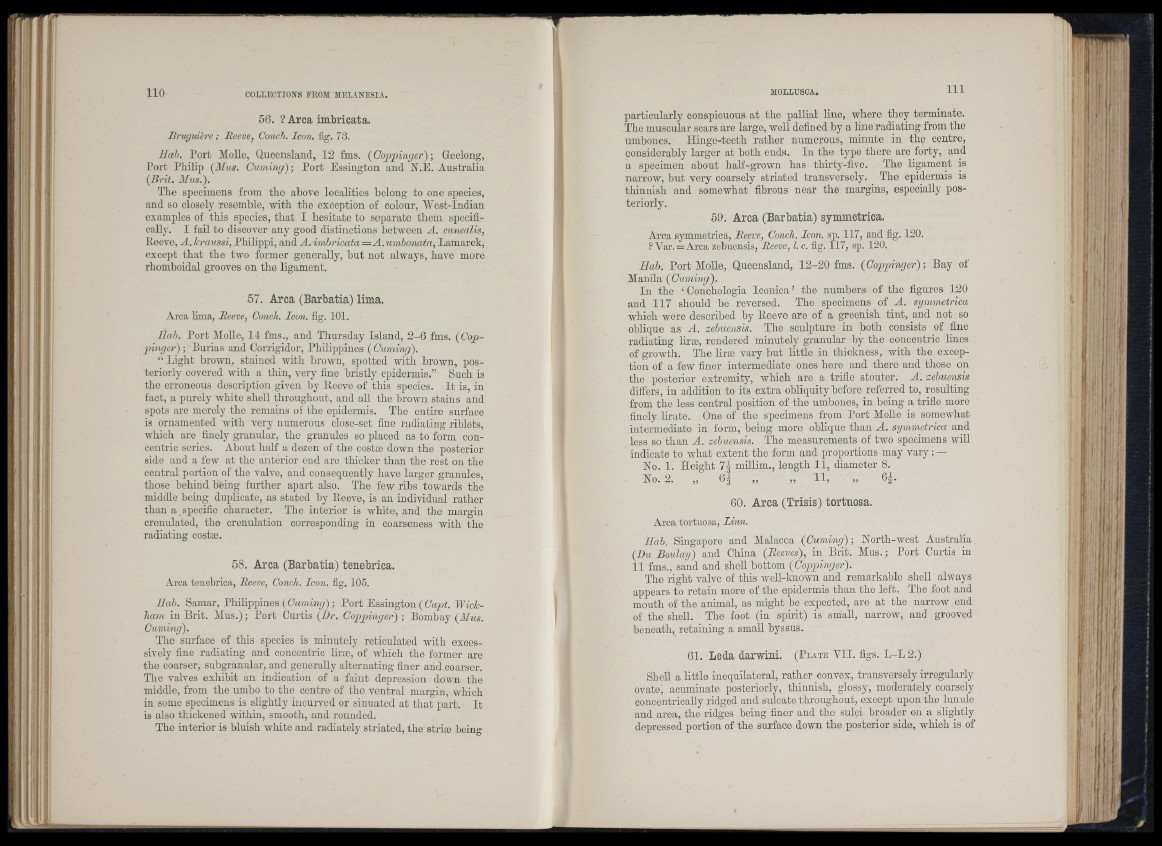
!
I -
il
I
If ;:
j
56. ? Area imbrieata.
Bruguihre ; Eeeve, Coneh, Icon. fig. 73.
Ilah. Port Molle, Queensland, 12 fms. {Coppinger); Geelong,
Port Philip {Alas. Cuming) ; Port Essington and N.E. Australia
{Brit. Alus.).
The specimens from tho above localities belong to one species,
and so closely resemble, with the exception of colour, AVest-Indian
examples of this species, th at I hesitate to separate them specifically.
I fail to discover any good distinctions between A. cunealis,
lleeve, A. kraussi, Philippi, and A . imbricata = A . umbonata, Lamarck,
except th at the two former generally, but not always, have more
rhomboidal grooves on the ligament.
57. Area (Barhatia) lima.
Area lima, Eeeve, Conch. Icon. fig. 101.
Ilah. Port Molle, 14 fms., and Thursday Island, 2 -6 fms. {Copqnnger)
; Burlas and Corrigidor, Philippines ( Cuming).
“ Light brown, stained with broAvn, spotted with brown, posteriorly
covered Avith a thin, very fine bristly epidermis.” Such is
the erroneous description given by Beeve of this species. I t is, in
fact, a purely Avhite shell throughout, and all the brown stains and
spots are merely the remains of the epidermis. Tho entire surface
is ornamented with very numerous close-set fine radiating rihlets,
which are finely granular, the granules so placed as to form concentric
series. About half a dozen of the costæ down the posterior
side and a few at the anterior end are thicker than the rest on the
central portion of tho valve, aud consequently have larger granules,
those behind being further apart also. The few ribs towards the
middle being duplicate, as stated by Beeve, is an individual rather
than a specific character. The interior is white, and the margin
crenulated, tho crenulation corresponding in coarseness with the
radiating costæ.
i
i
58. Area (Barhatia) tenebrica.
Area tenebrica, Eeeve, Conch. Icon. fig. 105.
Hab. Samar, Philippines (Gttmn^) ; Port Essington (Ga^ni. Wickham
in Brit. Mus.) ; Port Curtis {Hr. Coppinger) ; Bombay {AIus.
Cuming).
Tho surface of this species is minutely reticulated with excessively
fine radiating and concentric liræ, of Avhich the former are
the coarser, suhgrannlar, and generally alternating finer and coarser.
The valves exhibit an indication of a faint depression down the
middle, from the umbo to the centre of the venrial margin, which
in some specimens is slightly incurved or sinuated at th a t part. I t
is also thickened within, smooth, and rounded.
The interior is bluish white and radiately striated, the striæ being
particularly conspicuous at the pallial line, where they terminate.
The muscular scars are large, well defined by a line radiating from the
umbones. Hinge-teeth rather numerous, minute in tho centre,
considerably larger at both ends. In the type there aro forty, and
a specimen about half-grown has thirty-five. The ligament is
narrow, but very coarsely striated transversely. The epidermis is
thinnish and somewhat fibrous near the margins, especially posteriorly.
59. Area (Barhatia) symmetrica.
Area symmetrica, Eeeve, Conch. Icon. sp. 117, and fig. 120.
? Var. = Area zebuensis, Eeeve, I. c. fig. 117, sp. 120.
Hab. Port MoUe, Queensland, 12-20 fms. {Coppinger); Bay of
Manila {Cuming).
In the ‘ Conchologia Iconica ’ the numbers of the figures 120
and 117 should he reversed. The specimens of A . symmetrica
which were described by Beeve are of a greenish tin t, and not so
oblique as A . zebuensis. The sculpture in both consists of fine
radiating lirce, rendered minutely granular by the concentric lines
of growth. The lira? vary hut little in thickness, with tho exception
of a few finer intermediate ones here and there and those on
the posterior extremity, which are a trifie stouter. A . zebuensis
differs, in addition to its extra obliquity before referred to, resulting
from the less central position of the umbones, in being a trifie more
finely lirate. One of the specimens from Port Molle is someAvhat
intermediate in form, being more oblique than A . symmetrica and
less so than A . zebuensis. The measurements of two specimens will
indicate to what extent the form and proimrtions may v a ry : —
No. 1. Keight 7§ millim., length 11, diameter 8.
No. 2. ,, 64 ,, ,, 11, ,, 64.
60. Area (Trisis) tortuosa.
Arca tortuosa, Linn.
Hab. Singapore and Malacca {Cuming); North-west Australia
{Hu Boulay) and China {Beeves), iu Brit. Mus.; Port Curtis in
11 fms., sand and shell bottom {Coppinger).
The right valve of this well-knoAvn and remarkable shell always
appears to retain more of the epidermis than the left. The foot and
mouth of the animal, as might be expected, are at the narrow end
of the shell. The foot (in spirit) is small, narrow, and grooved
beneath, retaining a small byssus.
61. Leda darwini. (P la te Y II. figs. L-L 2.)
Shell a little inequilateral, rather convex, transversely irregularly
ovate, acuminate posteriorly, thinnish, glossy, moderately coarsely
concentricaUy ridged and sulcate throughout, except upon the lunule
and area, the ridges being finer and the sulci broader on a slightly
depressed portion of the surface down the posterior side, which is of
Î
i